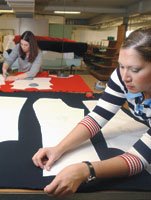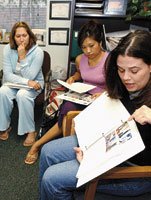Cal Poly Students Find an Ally in American Apparel
Fashion students rarely get a grasp of the “real world” of apparel production until they graduate and get jobs, but Los Angeles manufacturer American Apparel Inc. is helping some students get an early taste of the industry through a hands-on production program with California State Polytechnic University, Pomona.
The garment manufacturer has become a partner in Cal Poly’s Apparel Merchandising and Management department. It has opened its factory to the college’s AM2 production program, which allows students to produce a garment line from concept to finish. Students then sell the line at a general goods store and bookstore on campus, so they also get a feel for how to merchandise and market.
“Our students see the entire product development and production process this way,” said Associate Professor Cindy Regan, who coordinates the program. “The students get to see realism. For example, this summer, when we received the production samples back, one design was missing [the shirring] design detail that the student wanted. She learned that details such as pattern notches are critical in conveying how to sew a production garment.”
With the help of American Apparel, the 3-year-old program has progressed significantly. It’s one of only 13 programs in the country to receive an endorsement from the American Apparel & Footwear Association.
Regan first approached American Apparel to contract the cutand- sew operations for the line, but the company’s senior partner, Sam Lim, wanted to give the students a complete experience. The company took on two student interns last year and five students this summer to oversee production of the AM2 line.
Sixteen students are participating in the 10-week program. They break up into different groups to address issues such as distribution, utilization and plant operations. At the end of their studies, they make presentations to their instructors as well as to American Apparel executives.
“They were very good presentations,” said American Apparel Vice President of Operations Marty Bailey. “As outsiders looking in, they provided some unique insight, and we implemented some of their ideas.”
American Apparel officials were recently so impressed with some students that they hired them on the spot upon graduation.
“It’s almost like a 10-week interview or evaluation, so you know what you’re getting,” Bailey said.
The students are involved in custom sewing, patternmaking, grading, spreading and cutting. They also work on graphics and merchandising. They follow their designs through the manufacturing process. When they reach the retail level, students set up displays and control inventory for all clothing at the campus’ Farm Store.
Regan said that as the last class moved into pattern development, fit became a critical issue since the student designers produced garments including a fitted T-shirt, a fitted polo shirt, a miniskirt, a color-block sweat shirt, a low-waisted pant and a capri-style pant. They worked closely with American Apparel employees to perfect their patterns.
Technology is a particular area of focus, said Regan.
“We ingrain technology into our students,” she explained. “They learn Adobe Illustrator and Photoshop in their first product development class. In the second product development class, the students learn KaratCAD, an industry technical design CAD program, and Excel spreadsheets to create specifications. In Product Development III, the students learn Tukatech’s software programs. Students learn Lectra’s software programs in Product Development IV.”
Regan also leads student teams in conducting analysis of demographics, competition, trends, fabrications, colors and creative details. First, students develop product development calendars and action plans. Regan then introduces the teams to a consumer marketing approach, called “House of Quality,” to identify what consumers want and to incorporate specific consumer demands into a product’s design.
Bailey of American Apparel thinks other manufacturers can learn from Cal Poly’s program.
“It works to expose the students outside of a classroom setting,” he said. “It’s a unique opportunity.” —Robert McAllister
























